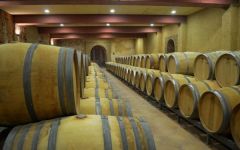Mustiguillo Atance Bobal 2020
-
Robert
Parker



Product Details
Your Rating
Somm Note
Winemaker Notes
Organic viticulture and hand picked grapes from bush vines in Requena, specifically the Casa Segura estate vineyards with well drained, sandy soils.
Professional Ratings
-
Robert Parker's Wine Advocate
The 2020 Atance, pure Bobal from vines planted in 1975, fermented in 10,000-liter stainless steel tanks with indigenous yeasts at controlled temperature for a week and had a short maceration. The wine matured in 8,000-liter French oak vats for three months. This feels really harmonious, serious, nuanced and elegant, with subtle aromas and great balance and length.
Rating: 91+
Other Vintages
2015-
Robert
Parker





A relatively new winery, Mustiguillo was created to give a place and prominence to the unheralded varietal Bobal. The owners believe strongly that this grape, when cropped low and harvested later, can produce wines that rival some of the greatest wines of Northern Spain. As such, many of the old vines of the property have been kept (some as old as 90 years old) and new vines of Bobal have been planted as well.
Utiel-Requena lies on a warm, arid plateau at an average of 700 meters above sea level. Mustiguillo owns four distinct parcels scattered throughout the zone including two over 800 meters. Soil structure is quite poor, with low amounts of organic material. Gravel, some clay, and smaller amounts of limestone make up the bulk of the vineyards. Rainfall is lower than the Spanish average and this shortage is thought to contribute to the excellent fruit concentration of these vines.

Bobal is enjoying a mini renaissance in Spain today as high-elevation vineyards in its homeland of Utiel-Requena produce dense and velvety wines dominated by dark berry and cocoa characteristics. However, its function as Spain’s second most planted red grape variety was once only for bulk wine and concentrate. Since it is drought-resistant, it does well grown as unirrigated bush vines and acts as a fine voice of terroir. Somm Secret—Bobal also shows great potential for rosé and sparkling wines because of its high levels of acidity and anthocyanins.

The Valencia DO wine region is a non-contiguous appellation, with four distinct subzones, surrounding the area beyond Valencia’s capital city. Winemaking in the northern part of this region is dominated by old growing areas surrounding the city. The region was established in 1957.
Historically, bulk wine has been the focal point of the region and cooperatives still handle 85% of total production today. However, winemakers are trying to steadily move away from this and focus more on producing quality wine thanks to a growing group of local innovative winemakers. More importance is being placed on older vines of indigenous (or historic) varieties planted at higher altitudes, which range from 820 - 3,600 feet.
There is growing excitement about the wines being produced from black grapes such as Monastrell, as well as late-ripening white grapes such as Merseguera. The most planted grape, Moscatel de Alejandría, has its own subzone centered around the production of sweet, fortified liqueur wines, called locally Mistela de Moscatel. The region's reds, rosés and whites actually all include dessert wines, each with their own wine-making traditions.
